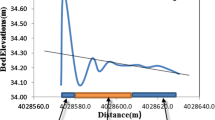Abstract
In this study, we modified and applied an open source CFD software package, the TELEMAC, to simulate sediment transport and bed morphology around Gangjeong Weir on Nakdong River in Korea. The simulations have been carried out with the real river bathymetry and the weir geometry, and for different operation scenarios of the weir. The hydrodynamic parameters and bed evolutions obtained from the numerical results have been validated against field observation data. Particularly, the scour depth has been verified against the results obtained from a well-known empirical formula. Agreement between numerical computations, observed data and empirical formulas is judged to be satisfactory on all major comparisons. This study is not only to point out the locations where deposition and erosion taken place due to the weir gate operation, but also to analyze the mechanism of formation and evolution of scour holes after the weir gates.
Similar content being viewed by others
References
Brière, C., Abadie, S., Bretel, P., and Lang, P. (2007). “Assessment of TELEMAC system performances, a hydrodynamic case study of Anglet, France.” Coastal Engineering, Vol. 54, No. 4, pp. 345–356.
Chang, H. H. and Hill, J. C. (1976). “Computer modeling of erodible flood channels and deltas.” Journal of Hydraulics Division, ASCE, Vol. 102, No. HY 10, pp. 132–140.
DHI (1997). Mike models, http://www.mikebydhi.com/.
Galland, J. C., Goutal, N., and Hervouet, J. M. (1991). “TELEMAC: A new numerical model for solving shallow water equations.” Advances in Water Resources AWREDI, Vol. 14, No. 3, pp. 138–148.
Hoffmans, G. J. C. M. (2012). The influence of turbulence on soil erosion, Eburon.
Hoffmans, G. J. C. M. and Verheij, H. J. (1997). Scour manual, Balkema, Rotterdam.
Holly, F. M. and Rahuel, J. L. (1990). “New numerical/physical framework for mobile-bed modeling.” Journal of Hydraulic Research, Vol. 28, No. 4.
Holly, F. M., Yang, J. C., Schovarz, P., Scheefer, J., Hsu, S. H., and Einhellig, R. (1990). CHARIMA numerical simulation of unsteady water and sediment movements in multiply connected networks of mobile-bed channels, IIHR Report No. 0343, University of Iowa, Iowa, USA.
Karim, M. F. and Kennedy, J. F. (1982). IALLUVIAL: A computer-based flow and sediment routing for alluvial streams and its application to the Missouri River, Iowa Institute of Hydraulic Research, Report No. 250, University of Iowa, Iowa, USA.
NCCHE (2009). CCHE3D, National Center for Computational Hydroscience and Engineering, University of Mississippi, http://www.ncche.olemiss.edu/cche3d.
Olsen, N. R. B. (1994). SSIIM-A three-dimensional numerical model for simulation of water and sediment flow, HYDROSOFT-94, Porto Carras, Greece.
Serrano, M. C. and Nguyen, V. Th. (2013). “Numerical simulation of sediment transport and bedmorphology around Gangjeong weir in Nakdong River.” 2013 Korean Society of Civil Engineering Civil Expo, October 24–25, Korea.
Simons and Li Assoc. Inc. (1980). Scour and sediment analysis of the proposed channel of the Salt River for protection of the Sky Harbor International Airport in Phoenix, Arizona, Kansas City, Missouri, USA.
Spasojevic, M and Holly, F. M. (1988). Numerical simulation of twodimensional deposition and erosion patterns in alluvial water bodies, IIHR Report No. 149, University of Iowa, Iowa, USA.
Steffler, P. and Blackburn, J. (2002). Introduction to depth averaged modeling and users’s manual, University of Alberta, Canada.
Thomas, W. A. and Prashum, A. L. (1977). “Mathematical model of scour and deposition.” Journal of Hydraulics Division, ASCE, Vol. 110, No. HY11, pp. 1613–1641.
Thomas, W. A. and Mcanally, W. H. (1985). User’s manual for the generalized computer program system open channel flow and sedimentation TABS-2, Department of the Army Waterways Experiment Station, Corps of Engineers, Vicksburg, Mississippi, USA.
Van Rijn, L. C. (1984). “Sediment transport, part I: Bed load transport.” Journal of Hydraulic Engineering, Vol. 110, No. 10, pp. 1431–1456.
Van Rijn, L. C. (1993). Principles of sediment transport in rivers, estuaries and coastal seas, Aqua Publications.
Villaret, C., Hervouet, J. M., Kopmann, R., Merkel, U., and Davies, A. G. (2013). “Morphodynamic modelling using the Telemac finiteelement system.” Computers & Geosciences, Vol. 53, pp. 105–113.
Wu, W. M. (2001). CCHE2D Sediment transport model, Technical Report No. NCCHE-TR-2001-3, National Center for Computational Hydroscience and Engineering, University of Mississippi, USA.
Author information
Authors and Affiliations
Corresponding author
Rights and permissions
About this article
Cite this article
Nguyen, V.T., Moreno, C.S. & Lyu, S. Numerical simulation of sediment transport and bedmorphology around Gangjeong Weir on Nakdong River. KSCE J Civ Eng 19, 2291–2297 (2015). https://doi.org/10.1007/s12205-014-1255-y
Received:
Revised:
Accepted:
Published:
Issue Date:
DOI: https://doi.org/10.1007/s12205-014-1255-y




